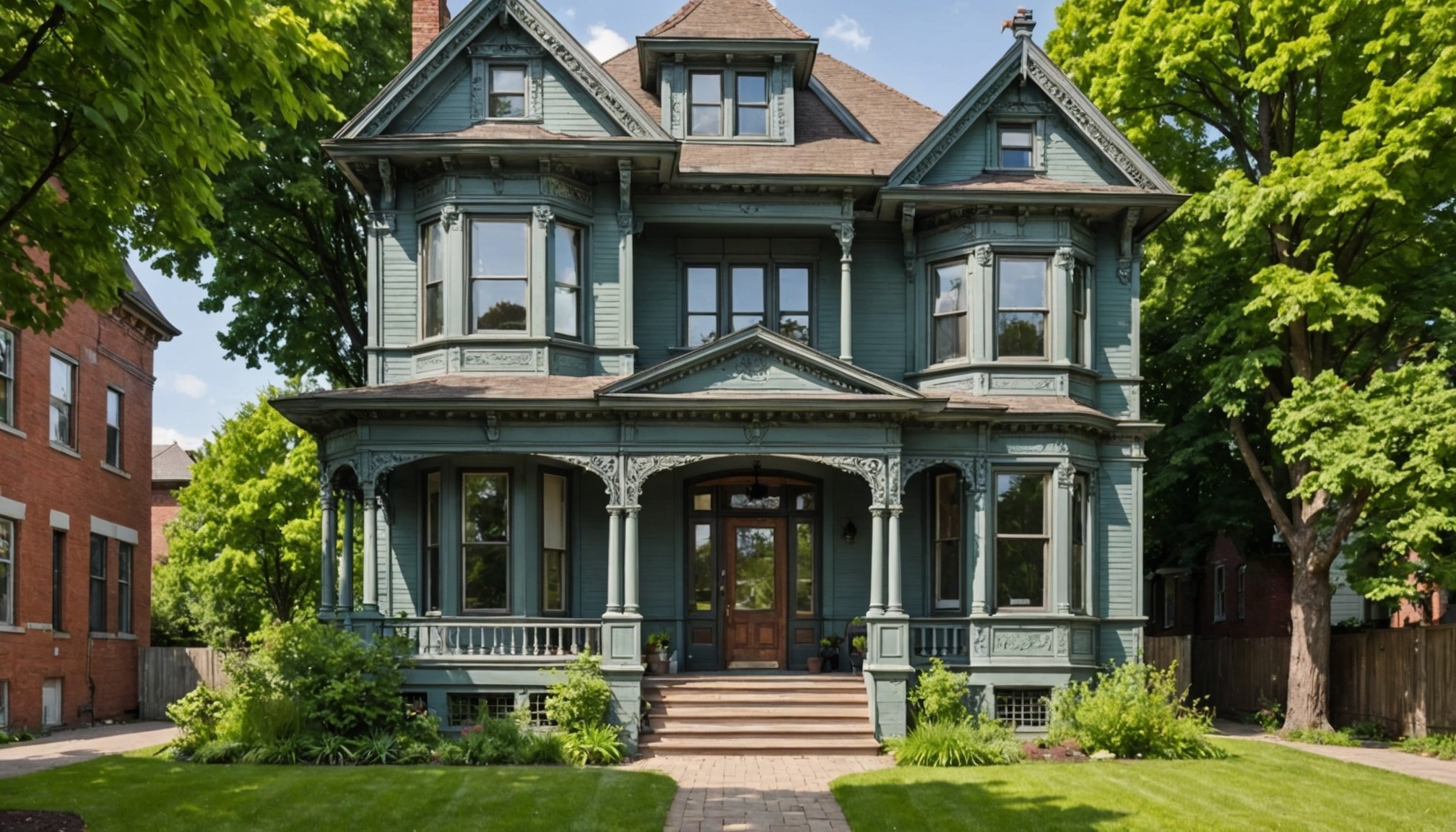Energy-Efficient Systems for Victorian Homes
Improving energy efficiency in Victorian homes is both an art and science. These charming structures often come with antiquated systems that aren’t conducive to modern energy standards. However, by incorporating state-of-the-art HVAC systems, Victorian homes can significantly reduce their environmental impact and utility bills. Opt for systems that are specifically designed to serve older architecture without altering its core beauty.
Addressing insulation is crucial. Victorian homes notoriously lack effective insulating techniques, often leading to energy wastage. Installing insulation that is both efficient and respectful of historical elements can preserve the architectural integrity while improving energy retention. Materials such as sheep’s wool, cellulose, or spray foam offer low-impact solutions.
This might interest you : Unveiling the Influence of Green Bonds on Sustainable Real Estate Funding in the UK
Windows, another significant source of energy loss, can benefit from innovative window treatments and technologies. Options like double glazing or thermal curtains maintain the classic aesthetic yet improve energy conservation. Modern films applied to glass can reduce heat gain without impacting historical styles.
Implementing energy-efficient systems enables homeowners to maintain the uniqueness of their Victorian houses while keeping them comfortable year-round. Balancing innovation with tradition is key to ensuring that these homes remain both historically significant and functionally modern.
Also to read : Unlocking Profit: The Ultimate Real Estate Investor’s Guide to Leveraging Tax Incentives for Sustainable Success
Overview of Eco-Friendly Renovation Techniques
Embracing eco-friendly renovation in Victorian homes is essential for balancing historical preservation and environmental sustainability. This approach not only honours the architectural past but also reduces the carbon footprint, aligning with modern environmental responsibilities.
Victorian architecture uniquely poses challenges during the renovation process. Its intricate woodwork, high ceilings, and detailed mouldings often require special attention. Hence, sustainable restoration must consider not only the materials used but also the modified techniques that uphold these key characteristics while enhancing energy efficiency.
- Sustainable solutions:
- Use eco-friendly materials like reclaimed wood to harmonize with existing designs.
- Opt for eco-friendly paints and stains that maintain original charm while minimizing toxicity.
- Employ new techniques that reduce material wastage and energy consumption without altering historic structures.
Modern technology offers processes such as the careful use of energy-efficient lighting and heating systems that seamlessly integrate into the home without disrupting its classical allure. Sustainable restoration enhances a building’s lifespan without overshadowing its historic essence.
By adopting eco-friendly renovation methods, homeowners and renovators can ensure Victorian homes continue to enchant future generations while standing as testaments to sustainable progress.
Sustainable Materials for Renovation
Selecting the right sustainable building materials is essential for those looking to restore Victorian homes while honouring their rich history. One of the key benefits of employing sustainable materials is their reduced environmental impact in comparison to traditional options. These materials not only offer eco-friendly solutions but also align with the aesthetic qualities inherent in Victorian design.
When considering options, reclaimed materials like bricks or wood from older structures are particularly beneficial. They imbue a sense of authenticity and offer a historical continuity, thus seamlessly integrating with original designs. Additionally, they help preserve resources by repurposing existing materials rather than utilising new ones.
Opt for eco-friendly options such as low-VOC paints that reduce indoor air pollution without compromising on finish or colour range. Flooring made from bamboo or cork provides durable yet stylish alternatives that complement the Victorian look.
Lighting and fixtures crafted from recycled metals can also enhance a space’s aesthetic while adhering to sustainability principles. Such thoughtful choices reflect a commitment to environmental preservation while maintaining the elegance synonymous with these historic homes. By integrating these materials, renovators can achieve an ideal balance of sustainability and historical fidelity.
Case Studies of Successful Eco-Friendly Renovations
Exploring renovation case studies provides real-world insights into how Victorian homes can undergo sustainable transformations. A notable example involves a home in Bath, England, where renovators employed respectful sustainable methods to retain its original charm. Key to this project was the use of eco-friendly options such as reclaimed wood and low-VOC paints, illustrating how these materials harmonize with historical aesthetics.
An important aspect these case studies highlight is the multitude of challenges faced during renovation, such as navigating structural fragility and adhering to preservation regulations. The Bath project faced significant challenges but successfully overcame them by integrating modern insulation techniques that respected the home’s integrity. This example shows that it’s possible to preserve historical aesthetics while implementing energy-efficient solutions.
Lessons from these projects include the necessity for thorough planning and the selection of the right professionals—those knowledgeable in both eco-friendly renovations and the intricacies of Victorian architecture. In doing so, the balance between historical restoration and modern efficiency is maintained, offering valuable guidance for future renovation projects. By examining these successful renovations, one gains confidence and inspiration for engaging in their own sustainable projects of this kind.
Maintaining Historical Aesthetics
Preserving historical aesthetics in Victorian renovations demands a respectful blend of old and new. It requires strategies that enhance a home’s charm without detracting from its original beauty. Careful selection of decor that aligns with the Victorian era is crucial. This might involve sourcing period-appropriate furnishings or evaluating colour schemes that complement existing architectural features.
Techniques that harmonise modern improvements with traditional Victorian designs are vital. Introducing technological advancements, like energy-efficient lighting, should be done subtly, maintaining the visual integrity of the space. For instance, opting for fixtures styled after Victorian gas lamps can modernise while preserving historical charm.
Working with professionals who specialise in historical home restoration is paramount to ensure renovations uphold the home’s legacy. Such experts possess the knowledge of both the Victorian decor and the unique structural characteristics of these homes, allowing enhancements that honour tradition.
To achieve a seamless balance, renovators should consider immersive consultation processes that factor in historical significance alongside modern convenience. This thoughtful approach supports the building’s original story, offering residents the chance to enjoy both modern amenities and Victorian splendour without compromise.
Integrating Modern Amenities
Transforming a Victorian home without losing its unique charm involves tactfully integrating modern amenities. This enhancement provides both comfort and efficiency in daily living, while preserving the historical character. The role of smart home technology in this transformation cannot be overstated. Devices such as thermostats and smart lighting offer unparalleled convenience and energy management while being discreetly integrated within the home’s architecture.
Upgrades should be executed with precision. Technology must not overshadow the home’s original characteristics. Employing hidden wiring solutions and selecting smart control panels styled in period-appropriate designs ensures the home’s historical appeal remains intact. In essence, these upgrades are a bridge between the past and present, allowing homeowners to enjoy the best of both worlds.
The best practices for retrofitting systems involve engaging with skilled professionals who have experience working with older homes. These specialists are adept at seamlessly combining the old with the new. By assessing structural integrity and understanding the intricacies of Victorian architecture, they ensure modern implementations are sympathetic to the house’s history. This meticulous balance ensures that residents enjoy cutting-edge comfort within a setting that honours its elegant past.
Resources for Professionals and Community Support
Navigating the complexities of eco-friendly renovation for Victorian homes requires the expertise of seasoned renovation experts. It is vital to connect with those who understand the balance between maintaining historical integrity and implementing contemporary solutions. This can often be achieved through professional organisations and networks dedicated to sustainable restoration.
Discovering skilled professionals in Victorian home restoration can transform a project’s outcome. Search for specialists with proven experience in integrating modern amenities and eco-friendly techniques within historical contexts. Online directories such as historical preservation societies often list qualified experts who can guide homeowners in these endeavours.
Besides professional resources, joining supportive communities—both online and locally—enriches the renovation experience. Platforms like forums and social media groups serve as invaluable points of connection, offering advice and sharing experiences.
Funding opportunities are another important aspect to consider. Numerous grants and subsidies are available for those committed to sustainable restoration. Government agencies and non-profit organisations frequently offer financial support to promote energy-efficient renovations that preserve historical architecture. Engaging with these resources not only eases the financial burden but also ensures the renovation aligns with environmental and community values.



